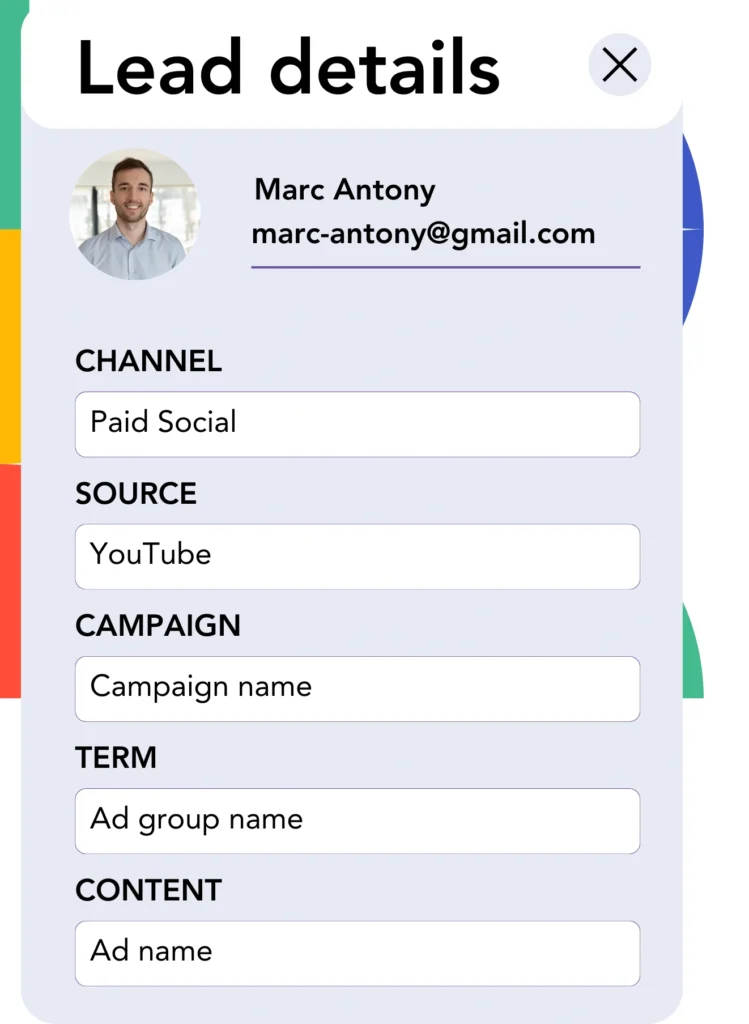You generate leads on YouTube and import them to Copper CRM, but you can’t match each lead with an individual YouTube ad. The issue also applies when a lead turns into a customer, as the initial YouTube ad remains unknown.
This lack of tracking prevents you from analyzing your YouTube ads performance, so you remain unsure which ads yield leads and customers. As a result, you spend on ads without knowing how well they’re performing.
Fortunately, an easy approach exists to match each lead to the exact YouTube campaign, ad group, and ad that brought it in.
Let’s work through each step!
How to Track YouTube Ads in Copper CRM
Step 1: Add Leadsources in the head tag of your website

Leadsources is a simple tool for tracking lead origins. Add it to your website, and it collects up to 7 details on each lead’s source.
➡️ Sign up to Leadsources.io for free
➡️ Add the Leadsources tracking code to your site
Step 2: Add the UTM parameters to your YouTube Ads

Add UTM parameters to your ad URL to track YouTube ad data, including campaign, ad group, and ad. Try this setup:
UTM_source=YouTubeUTM_campaign=campaign-nameUTM_term=ad-group-nameUTM_content=ad-name
This is how your final URL should look:
https://www.yourdomain.com/?&UTM_source=youtube&UTM_campaign=campaign-name&UTM_term=ad-group-name&UTM_content=ad-nameNote: Leadsources ensures comprehensive tracking by capturing lead source data, even when UTM parameters are missing.
Step 3: Add the hidden fields in your form

Hidden fields are form inputs that stay out of sight for the user, but they hold data that gets transmitted with the form.
Leadsources stores all lead source information in hidden fields. When a lead submits the form, these fields are filled with YouTube Ads data automatically.
Step 4: Capture the YouTube Ads data in Copper CRM

When users click on your ads and land on your page, Leadsources fetches the YouTube campaign, ad group, ad data, and other data.
The YouTube ad data is automatically filled into the hidden fields of your form by Leadsources.
After the form submission, you can check the YouTube ad data and lead details in Copper CRM (ensure that your form is connected to Copper CRM).
How does Leadsources work?
When a user arrives on your site, Leadsources fetches YouTube ad data and populates it into the hidden fields of your form. After the form is submitted, this data, along with the lead’s name and email, is forwarded to Copper CRM.
Leadsources tracks the source of each lead, keeping detailed data for every one:
| Lead source data | Fetched automatically |
| Channel | ✅ |
| Source | ✅ |
| Campaign | ✅ OR use UTM_campaign |
| Content | UTM_content parameter is required |
| Term | UTM_term parameter is required |
| Landing page | ✅ |
| Landing page subfolder | ✅ |
As seen in the table above, when UTM parameters cannot be applied—like for organic sources such as Google search or when your website is referenced in an article—Leadsources still captures the following lead source data:
- Channel
- Source
- Campaign
- Landing page
- Landing page subfolder
Leadsources stands out by tracking lead source data across every marketing channel, regardless of whether it’s paid or organic.
Performance reports: Lead, sales, and revenue by source
Tracking YouTube Ads data in Copper CRM lets you create detailed performance reports like:
- Leads, sales, and revenue by channel
- Leads, sales, and revenue by source
- Leads, sales, and revenue by campaign (aka. YouTube campaign)
- Leads, sales, and revenue by term (aka. YouTube ad group)
- Leads, sales, and revenue by content (aka. YouTube ad)
This allows you to maximize your YouTube Ads budget by emphasizing on the campaigns, ad groups, and ads that generate the most leads, sales, and revenue.
Let’s dive into some of the reports you can create!
1. Lead source reports
Generate detailed reports that outline the number of leads produced by:
- Channel
- Source
- Campaign (aka. YouTube campaign)
- Term (aka. YouTube ad group)
- Content (aka. YouTube ad)
- Landing page
- Landing page subfolder
Example #1: Leads by channel
By using this report, you can identify the channel that generates the greatest number of leads.

Example #2: Leads by YouTube campaign
You can now focus on a lead source (e.g., YouTube) and monitor the number of leads generated by each individual YouTube campaign.

Example #3: Leads by YouTube ad
Once you know which YouTube campaign is the most effective at generating leads, you can analyze the ad group or ad that’s producing them.

2. Sales and revenue source reports
Having found the YouTube campaign, ad group, and ad responsible for our leads, the next step is to evaluate whether these leads are turning into sales and revenue.
To track the sales and revenue from your marketing activities, integrate your leads into a CRM like Copper CRM. This allows you to follow the performance of different channels, sources, YouTube campaigns, ad groups, ads, landing pages, and subfolders.
This data allows you to realign your YouTube Ads strategy to focus on the channels, sources, campaigns, ad groups, and ads that contribute the most to sales and revenue.
You have the option to create various reports for sales and revenue tracking, such as:
- Sales and revenue by channel
- Sales and revenue by source
- Sales and revenue by campaign
- Sales and revenue by term (e.g., YouTube ad group)
- Sales and revenue by content (e.g., YouTube ad)
- Sales and revenue by landing page
- Sales and revenue by landing page subfolder
Example Scenario:
| Channel | Search Paid | Social Paid |
|---|---|---|
| Leads | 50 | 75 |
| Sales | 5 | 6 |
| Average Order Value | $150 | $100 |
| Revenue | $750 | $600 |
Once ads went live on Google and YouTube, the first “Leads by Channel” report showed that Social Paid ads on YouTube produced more leads than Google’s Search Paid ads.
Reviewing the sales and revenue data in Copper CRM, you realized that the Search Paid channel was outperforming the Social Paid channel in terms of revenue, even with fewer leads. You then made the decision to allocate more funds to the Search Paid channel.
LeadSources tracks the source of each lead in Copper CRM, whether they come from ads, organic search, social, email, etc. and syncs that data with each submission. See the full breakdown on the lead source in Copper CRM page.

